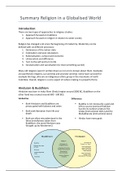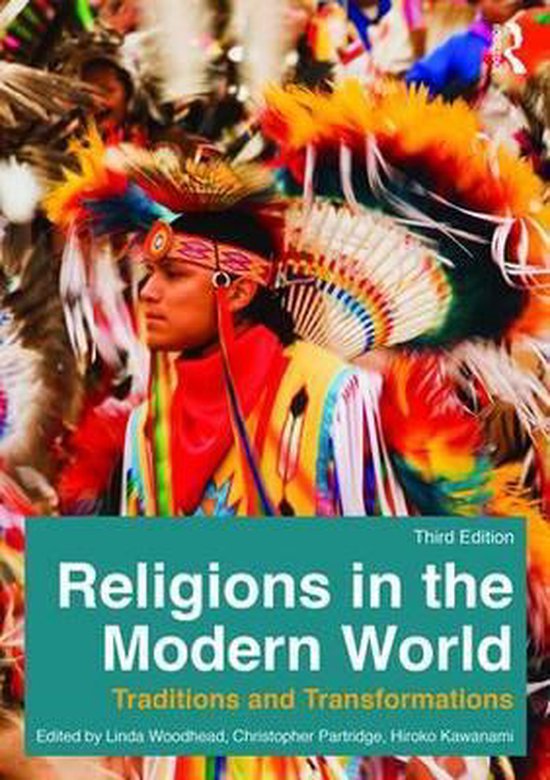Summary
Religion
in
a
Globalised
World
Introduction
There
are
two
types
of
approaches
to
religious
studies:
1. Approach
focused
on
traditions
2. Approach
focused
on
religion
in
relation
to
wider
society
Religion
has
changed
a
lot
since
the
beginning
of
modernity.
Modernity
can
be
defined
with
six
different
processes:
1. Dominance
of
the
nation
state
2. Colonialism
and
post
colonialism
3. Rationalisation,
cultural
and
economic
4. Universalism
and
difference
5. Turn
to
the
self
and
turn
to
life
6. Secularization
and
sacralisation
(to
treat
something
sacred)
Many
old
religions
weren't
written
down
so
not
a
lot
is
known
about
them.
Examples
are
pantheistic
religions,
sun
worship
and
ancestor
worship.
Some
have
survived
for
example
the
Kogi,
who
are
an
indigenous
ethnic
group
in
the
mountains
of
north
Colombia.
Overall,
religion
is
a
core
aspect
of
culture
making
it
a
powerful
force.
Hinduism
&
Buddhism
Hinduism
was
born
in
Indus
River
(Sindu)
region
around
2000
BC,
Buddhism
on
the
other
hand
was
created
around
600
-‐
500
BCE.
Similarities Differences
• Both
Hinduism
and
Buddhism
are
• Buddha
is
not
necessarily
a
god
and
preoccupied
with
balance
and
order.
left
no
source
text
but
Hinduism
has
the
its
earliest
scripture
the
• Both
seek
liberation
from
life
and
Vedas
(instructional
texts)
and
the
death
Mahabharata
(instructional
epics)
• Both
are
often
misunderstood
in
the
• Hindus
have
many
gods
West
(mindfulness
taken
from
Buddhism,
the
word
Hinduism
was
thought
up
by
Westerners)
, Hinduism
Hinduism
lays
out
a
vision
of
existence.
A
soul
(atman)
lives,
dies
and
is
reborn,
learning
and
growing
based
on
choices
(karma).
It
is
the
third
largest
religion
on
earth.
Hinduism
has
different
journeys
• Karma
Marga
-‐
ritual
and
social
obligations
• Jjana
marga
-‐
knowledge,
meditation
and
study
• Bhakti
Marga
-‐
devotion
and
worship
Dharma
is
the
cosmic
order.
To
preserve
it
one
must
carry
out
their
obligations
and
duties
in
written
and
unwritten
rules.
There
are
different
rules
for
different
groups
based
on
social
class
and
gender.
The
caste
system
is
engraved
in
the
religion
and
culture
on
all
levels
and
used
to
maintain
order
(in
Indian
society).
Aside
from
the
gods
with
a
physical
form
such
as
Vishnu,
Shiva
and
Devi,
there
is
also
Brahman,
the
ultimate
reality
underlying
all
phenomena
in
Hindu
scripture.
Hindus
usually
choose
a
specific
deity
to
worship
with
incense,
lights
and
flowers
(Puja).
Hindu
scripture
was
written
in
Sanskrit
and
mainly
kept
among
the
priestly
‘brahman’
caste.
In
all
Hindu
sacred
texts
the
gods
show
themselves
in
visible
form
and
are
described
by
inspired
sages.
In
relation
to
other
faiths
India
is
religiously
diverse
but
Hinduism
dominates
the
culture.
British
rule
gave
India
the
nation
state
and
scientific
rationality.
India
became
independent
from
British
rule
in
1947
and
was
partitioned
into
India
and
Pakistan,
which
was
mostly
non-‐violent
due
to
the
help
of
Ghandi.
But
Hindu
nationalists
destroyed
the
Ajodhya
mosque
in
1992
and
there
was
other
violence
between
Hindus
and
Muslims
in
India.
These
events
are
a
big
part
of
the
Hindu-‐Muslim
conflict.
Example
of
Hinduism
in
politics
today
Socio-‐economic
condition
of
India
today:
The
current
prime
minister
of
India,
Modi,
• Traditional
Hinduism
a nd
its
divinities
t hrive
is
part
of
the
BJP
political
party
and
• Reformed
unofficially
supports
the
nationalist,
forms
of
Hinduism
produced
by
western
influence
in
the
19
th
century
continue
extremist
group
RSS.
One
of
BJP’s
main
aims
is
Hindutva,
the
belief
that
India
• Gurus
gain
new
importance
and
take
Hinduism
to
the
west
should
be
Hindu
first
(and
n ot
M uslim
in
(often
w
ith
yoga)
particular).
Since
BJP
has
been
in
power,
a
• Women’s
spirituality
finds
increased
scope
and
expression
citizen
act
has
b een
passed,
which
• Caste
is
still
important
but
the
low
castes
have
gained
discriminates
against
Muslims
and
there
influence
and
the
priestly
caste
has
declined
have
been
many
violent
attacks
against
• Hindu
nationalism,
the
idea
that
India
belongs
to
Hindus
Muslims
and
politically
left
groups.
alone,
is
growing
Whether
this
is
really
Hindu
is
extremely
debateable
but
BJP
are
using
Hinduism
to
promote
their
position.
(article)
, Buddhism
Buddhism
is
one
of
India's
faiths
and
ranks
fourth
among
world
religions.
It
has
Hindu
roots
and
overlapping
ideas
of
reincarnation,
order
and
enlightenment.
It
begins
with
a
story
of
the
prince
Siddhartha
Gautama
(490
–
10
BCE)
from
the
kingdom
of
Sakyas
who
was
born
to
become
a
king.
Siddhartha
escapes
the
palace
and
experiences
suffering.
He
decides
to
seek
enlightenment
and
finally
finds
it
under
a
Bodhi
tree
by
essentially
avoiding
temptation.
Siddhartha's
discovery
The
four
noble
truths
of
Buddhism:
1. Life
is
suffering
2. Suffering
is
caused
by
desire
3. You
can
learn
to
overcome
suffering
(through
meditation)
4. Follow
the
8-‐fold
path
-‐
do
what's
right
and
achieve
nirvana
Siddhartha
ends
up
teaching
Buddhism
but
doesn't
leave
behind
any
texts.
There
are
different
types
of
Buddhist
teachings:
• Theravada
school
-‐
focus
on
Buddha’s
original
teachings
• Mahayana
school
–
personal
spiritual
practice
and
assisted
enlightenment
• Tibetan
Buddhism
-‐
a
theocratic
approach
• Zen
Buddhism
-‐
accessible
meditative
philosophy
The
diverse
forms
of
Buddhism
can
be
categorised
into
three
major
groupings:
1. Southern
Buddhism
in
Sri
Lanka
and
Southeast
Asian
countries,
mainly
Theravada
schools,
the
sacred
texts
of
Southern
Buddhism
are
written
in
Pali
2. Northern
Buddhism
in
Tibet,
mainly
Mahayana
schools
3. East
Asian
Buddhism
in
China,
Korea,
Japan,
Taiwan,
mainly
Mahayana
Monasticism
(monks)
plays
a
big
role
in
all
groups
of
Buddhism
especially
with
Southern
and
Northern
Buddhism.
Sangha
is
the
Buddhist
monastic
order
including
monks,
nuns
and
novices.






